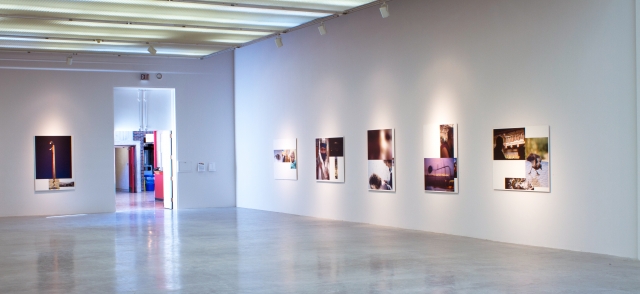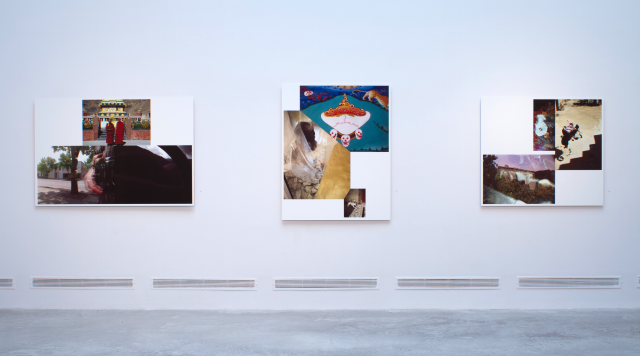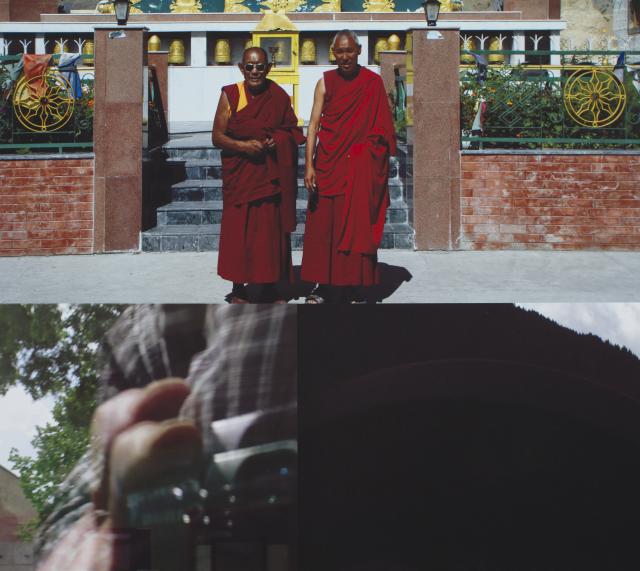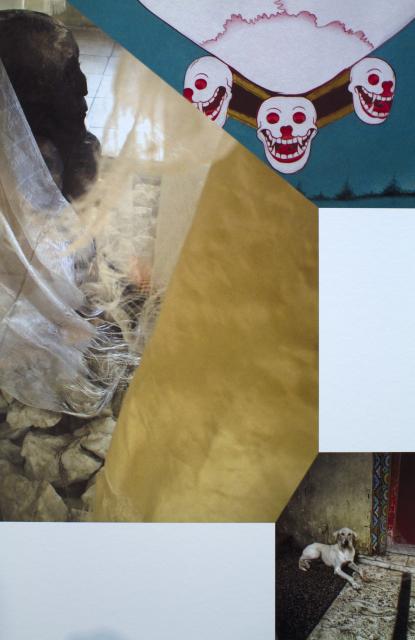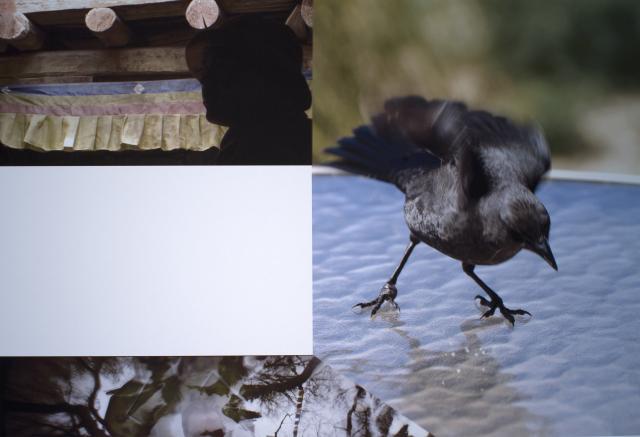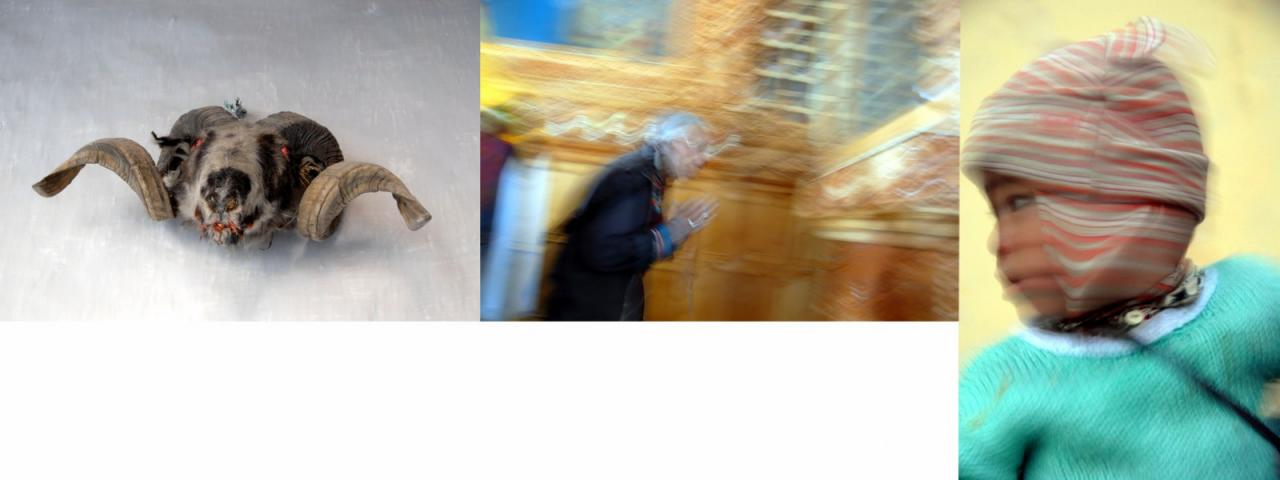
Exhibition
4 Sep 2013 - 21 Mar 2013
Illingworth Kerr GalleryFumbling for Readings Veiled by Shafts of Dust and Incense
Dennis J. Evans
Fumbling for Readings Veiled by Shafts of Dust and Incense
Dennis J. Evans
The seventeen large printed works on paper at the Illingworth Kerr Gallery are from four portfolios by Dennis J. Evans entitled Lioness/Lion, Look, You and Clairvoyance.
The montage prints juxtapose three thematically diverse photographs to represent new pictorial meta-structures of a highly personal human record. Empirical realities of ‘a place,’ the composite images act as autobiographical records but are not meant to be factual evidence of the artist’s perceived world. Rather Evans suggests they represent portals to encourage a suspension of reality and to trigger a viewer’s own personal narratives. As with most expressive forms the strength of the montages is their ambiguity, offering possibilities of varied and contrasting interpretations. Evans’ approach to montage is therefore aligned with a prevalent description of contemporary life as a network of unanchored flows, with site-specificity reimagined and consistently open-ended.
Thirteen of the montages are from the portfolios Lioness/Lion, Look and You. They have been obliquely inspired by two sources: the poems of the 13th-century Sufi mystic, scholar and poet Rumi, and a text by Coleman Barks, the best-known translator of Rumi’s seductive poetry. One reference by Barks is key to Evans’ investigation. In his book, Feeling the Shoulder of the Lion, Barks speaks of Rumi’s subjective reference to the lion: “Sometimes fasting, sometimes feasting, the lion does not discriminate. The lion has the power to control or indulge. This is not a passive animal, it has dignity and the energy of ornery independence.” Rumi recognizes both the lion’s physical presence and its discerning energy. This recognition of the physical and the psychic is a key element in Evans’ visual language as he aims to capture a spiritual element of awe and reflection while avoiding any definitive statement.
The presence of the lion is also echoed in Barks’ reading of Nietzsche’s Thus Spoke Zarathustra: A Book for All and None. This particular reading is significant for Evans and he writes: “Zarathustra speaks of the three stages of psychic metamorphosis of the spirit, represented by the camel, the lion and the child. The camel: Devotee, proudly carries burdens, and kneels to a teacher and teachings. The lion: Does not imitate, elects to be free, lord in its own wilderness. The child: Innocence, representing a new beginning. It is my deliberate decision in not assigning specific images to Zarathustra’s metamorphic identifications. In order for the work to stay alive and have multiple meanings it is fundamental that the associations of the images within the montages be interactive and interchangeable.”
“Rumi celebrates the omnipresent YOU. In Persian there is a pronoun that describes ‘I, you, he, she, it and God.’ Apparently it is singular and plural, all-inclusive. Barks elects to use YOU as an English substitute to personalize our connectedness and interdependence. His piquant use of YOU accentuates our common humanity and our universality. My interest is to create transcendent connections that imply and penetrate these values and subtle relationships.”
Four new works, entitled Clairvoyance, are included in the exhibition. These works are informed by the artist’s desired ability to be clairvoyant, to see around corners. Evans admits that this possibility is usually not recognized within the field of logic or valid inference. But the concept of the irrational is prominent in contemporary visual language. It is associated with a transcendent state of mind that speaks of the destabilizing of reality, subjectivity, identity and spatiality. The four new works, not unlike the earlier works that comprise Lioness/Lion, Look and You, transcend logical and linear readings. They are purposely designed as nonlinear compositions and their unconventional scale relationships override rational time and place sequences. The montages present an illogical mix of concerns related to history, geography and personal and spiritual identity. In the process Evans broadens the possibility of the viewer’s interpretation to go beyond the personal history of the artist and rely on imagination, intuition and, possibly, clairvoyance.
Evans’ creative process is a complex journey. He cites, among others, Wim Wenders, the renowned German filmmaker, and his approach to photographs. Wenders recognizes the making of photographs as a two-way activity that represents not only what is in front of the lens but also what lies behind it. Identity and difference are embedded equally in the photographic self-portrait. Evans likewise understands the use of a camera and producing images as a form of self-portraiture. For Evans the montages rely on the ineffable in self-portraiture, the brief snatches of seemingly inconsequential reflections that are simultaneously lucid invitations to elicit and share personal experiences, memories and stories. Evans’ approach to “portraiture” is a significant meditation on contemporary life and becomes a sophisticated critique of the flow of images and signals most viewers encounter on a daily basis. Fumbling for Readings Veiled by Shafts of Dust and Incense presents a mature practice of story telling and self-transformation based on a system of inquiry that aims to open new avenues to value human perception and social interaction. Rather than invoking equivalencies via the flow of one thing after another, Evans’ work addresses difference – the adjacencies and distances between the representation of one thing, one person, one place, one thought, or one fragment placed next to another.
Dennis J. Evans
Dennis J. Evans studied sculpture and drawing at Ohio State University, received a BFA from the Cleveland Institute of Art and a MFA from the University of North Carolina at Greensboro before moving to Canada. Best known for his large-sale works on paper and installations such as the Straw Bale Observatory, Evans taught at ACAD and is currently professor emeritus in the Faculty of Fine Arts at the University of Regina.
The IKG would like to acknowledge the generous support of the Saskatchewan Arts Board for this exhibition and the intellectual support of ACAD faculty members, namely Rita McKeough, Ken Webb and Mitch Kern.
All images courtesy J. Kelly

